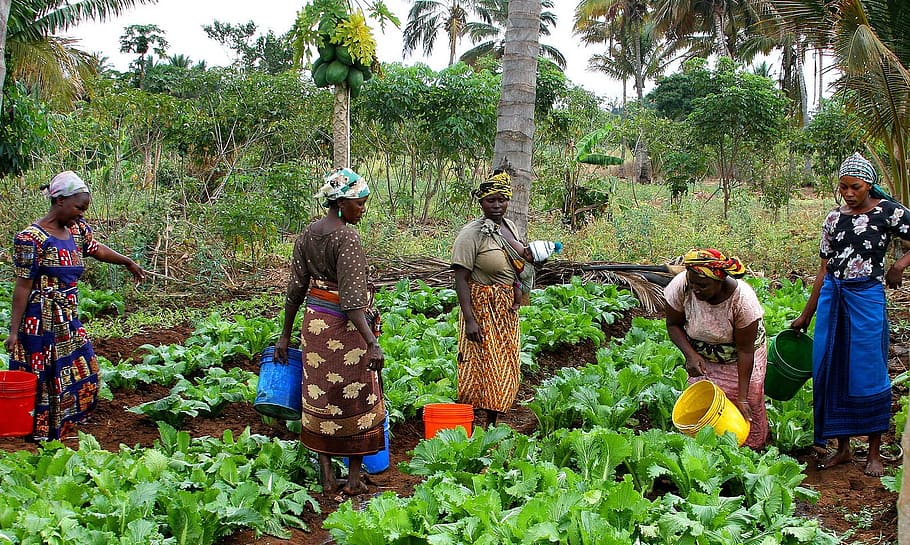With apocalyptic orange skies come fresh thoughts of the climate crisis. Let’s take a moment to consider a climate-related food system collapse.
In this culture, climate change too often seems like a far-off worry that could affect our grandchildren unless we all eat more legumes and switch to EVs, but smoky skies in New York last week rubbed the easily forgettable reality right in our faces so clearly that more people are starting to realize how bad it really is. While the apocalyptic orange scenery has your attention for a moment, please consider another alarming effect of the climate chaos that is, even now, gearing up for approach: the eventuality of large-scale food system collapse.
The first volley, as usual, is rising food prices. Even if all the world’s signatory countries meet their Paris Agreement targets (hahaha!), food prices are still headed upward as baked-in climatic instability is here to stay. Erratic rainfall, untimely frosts, droughts and floods, scorching summer temperatures, and yes, even wildfires and their windblown smoke, cause havoc for farmers, decimate crops, and make food more expensive, possibly pricing poorer nations and families right out of the food market.
As available resources like fresh water and topsoil dwindle, it’s easy to imagine conflicts brewing around rivers and the remaining arable land. Just as the Russian invasion of Ukraine precipitated crises for farmers and hungry people in Africa and the Middle East, tensions like those between urban and agricultural water consumers in the American West, or between French farmers vying for limited pools of water, could explode into bigger fights.
But wait, there’s more. Far more.
Professor Jem Bendell at the University of Cumbria, in the UK, released research last March which identified six hard trends which, cumulatively, point toward food system collapse. It’s worth reading the paper for yourself, but here’s the fast-forward summary of the trends Professor Bendell found.
First, we’re hitting the upper limit of how much food modern farming methods can produce. Past technological breakthroughs like the Haber-Bosch process, which fixed atmospheric nitrogen into ammonium nitrate for military (and, later, agricultural) purposes, certainly amped up food production, but the rate of technological innovation has slowed. What’s more, due to population growth, urbanization, development, desertification and degradation, there is no longer as much agricultural land on which to grow that food.
Second, our industrial culture is breaking the the natural world. This is where the effects of air and water pollution, loss of soil fertility, and collapse of pollinator species combine to reduce agricultural yields.
Third, modern food cultivation and distribution rely on declining fossil fuels, and, indeed, would not be possible without such unsustainable inputs. Massive centralization of agricultural land in fewer hands means that farmers depend upon diesel-powered machinery to plant, harvest, process, and transport crops. About a third of global energy consumption and greenhouse gas emissions can be attributed to modern food production.
Fourth, climate change is accelerating faster than expected, thereby making it harder to grow crops and produce food in the large quantities that modern civilization depends on. Extreme weather events like intense storms, droughts, floods, wildfires, and so forth, make agriculture less reliable. Failures of multiple breadbasket regions becomes more likely.
Fifth, demand for food is high and can’t be easily reduced. A growing population, fed by a growing food supply, now requires a permanently large food supply to feed all those people. Not only do they need more total food, but there’s a strong demand for more intensive food products, such as meat and dairy, especially as incomes rise and people who once lived in poverty have more disposable income.
Sixth, the globalized food system has been optimized for efficiency over resilience, and profit more than feeding the most people. Often, countries which most need food are the least able to afford to buy the food they need. Meanwhile, foodstuffs have become commodities that are manipulated for financial gain for a relative handful of big players. Centralized production, monocropping, and just-in-time distribution may be very efficient, as long as there are no disruptions. How long will there be no disruptions?

It’s not hard to see how these trends will interact in ways that lead to globalized food system collapse in a not-distant-enough future.
As the slippery path to collapse continues unabated, people will surely attempt fixes and workarounds, no matter how wacky those seem. Consider Arizona’s $5 billion plan to build a desalination plant in a Mexican town that doesn’t even have enough potable water for its own residents, and pipe that water right over the border to fill a need left by drought and declining access to a diminished and overused Colorado river. At what point does the expectation of continued growth in an increasingly uninhabitable desert region give way to the hard reality of resource depletion, when the population scatters and miles of roads, homes and strip malls become ruins?
Then there’s “vertical farming.” Hailed by many as the future of food production, this is where techy growers introduce a mountain of engineering and resource problems by taking crops out of the fields where sun and rain fall effortlessly, and put them in energy-intensive buildings with a lot of plastic and metal equipment and then have to figure out how to replace what nature once provided for free. Does this sound like a suitable way to grow anything, let alone crops more calorie-rich than lettuces and herbs, in a capital-poor, resource-depleted future? It is not, as Upward Farms discovered during their decade in business that ended earlier this year. Rising energy costs, technological complexity, poor volume, and deep unprofitability doomed vertical farming.
However, there are ways to mitigate a larger food system collapse. They won’t solve everything, and people won’t like them, but they exist, and perhaps they will like “not eating” even less.
It turns out that coal-fired power plants are bad neighbors for farmers and their crops. Between 2005 and 2016, shutting down coal plants resulted in 570 million more bushels of corn, soybeans, wheat, and similar crops grown on surrounding farmland. It turns out that getting rid of smog and sulfate aerosols allowed more sun to reach the crops, and increased photosynthesis resulted in greater food production. Extrapolated totals suggest that by keeping other coal plants running, we missed out on 10.2 billion bushels of food that could have been produced on existing farms over that time.
We could also go small and go home. Despite poverty and other challenges, smallholders produce about a third of all calories consumed globally, and do it on less than 11% of the world’s farmland. This suggests that tending smaller farms of mixed crops with simpler tools can produce more calories per acre than the monocropped megafarms run by one person in an air-conditioned combine. It would require a set of land reforms that are likely to be politically unpalatable, but if it is a choice between a comprehensive back-to-the-land movement and a food system collapse, what would you prefer?
If only that were the choice ahead of us, right? Instead, it is likelier to end up as a choice between land and food for the many, or energy and food for the richest, with the rest of us expected to behave peacefully and fade away, much like wildfire smoke as the wind changes direction.
Related: The Worth of Water as the River Runs Low


Join the conversation!